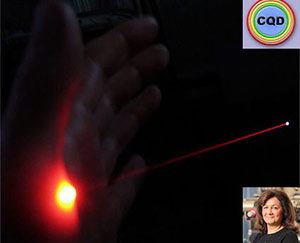Razeghi & CQD Center Create New Advances in Quantum Cascade Lasers
Led by Manijeh Razeghi, a team of researchers has designed a new laser technology with high power and high brightness.
New advances by Prof. Manijeh Razeghi and her Center for Quantum Devices (CQD) team have been highlighted in an article examining how using quantum cascade lasers are useful for chemical sensing. Her group was able to achieve this breakthrough using a remarkably simple technique: tilting the laser cavity.
Excerted from an Monday, March 16, 2015 article published by McCormick, titled, "Tilted Laser Cavities Make Brighter Beams."
A simple tilt of geometry recently made quantum cascade lasers (QCLs) even brighter.
Led by Prof. Manijeh Razeghi, the Walter P. Murphy Professor of Electrical Engineering and Computer Science, a team of researchers in the McCormick School of Engineering has designed a new laser technology with high power and high brightness. QCLs emit mid- to far-range infrared radiation that can be used for the detection of gases, chemicals, and pollutants in the atmosphere.
 Good beam quality is necessary for sending infrared light across great distances, but few structures have been able to achieve both high power and high brightness. Razeghi’s group in the Center for Quantum Devices was able to achieve this using a remarkably simple technique: tilting the laser cavity.
Good beam quality is necessary for sending infrared light across great distances, but few structures have been able to achieve both high power and high brightness. Razeghi’s group in the Center for Quantum Devices was able to achieve this using a remarkably simple technique: tilting the laser cavity.
“This is the highest power obtained from a single semiconductor laser,” Razeghi said. “Along with the record-breaking output power, the beam quality is also superior, making it the brightest QCL to date.”
The research is described in the paper “High brightness angled cavity quantum cascade lasers,” which was published in the March 6 issue of Applied Physics Letters. The paper’s first author, McCormick undergraduate David Heydari presented the results at SPIE Photonics West 2015, where he won the best paper award for Breakthroughs in Human-Centered Research.
Although this new structure is demonstrated in a QCL, there is no fundamental limit preventing the application of the angled cavity laser technology to a wide range of semiconductor lasers for power scaling along the beam quality control.
This research is partially supported by the National Science Foundation, Department of Homeland Security, Naval Air Systems Command, and NASA. Heydari’s work is supported by an undergraduate research grant.
